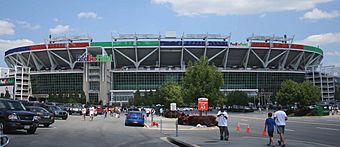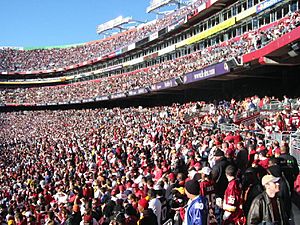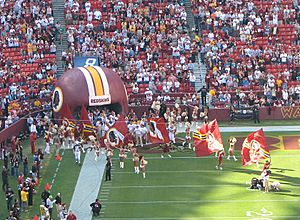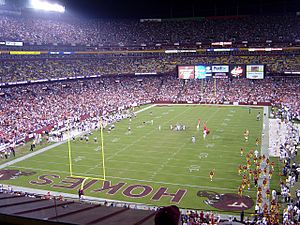FedExField facts for kids
 |
|

Exterior view in 2005
|
|
| Former names | Jack Kent Cooke Stadium (1997–1999) |
|---|---|
| Address | 1600 FedEx Way |
| Location | Landover, Maryland |
| Coordinates | 38°54′28″N 76°51′52″W / 38.90778°N 76.86444°W |
| Public transit | |
| Owner | Daniel Snyder |
| Operator | Washington Football Team |
| Executive suites | 243 |
| Capacity | 82,000 (2015–present) 79,000 (2012–2015) 83,000 (2011) 91,704 (2009–2010) 91,665 (2004–2008) 86,484 (2001–2003) 85,407 (2000) 80,116 (1997–1999) |
| Surface | Latitude 36 Bermuda Grass |
| Construction | |
| Broke ground | March 13, 1996 |
| Opened | September 14, 1997 |
| Renovated | 2011, 2012 |
| Expanded | 1998, 2000, 2005 |
| Construction cost | $250.5 million ($457 million in 2022 dollars ) |
| Architect | HOK Sport (now Populous) |
| Structural engineer | Bliss & Nyitray, Inc |
| Services engineer | M-E Engineers, Inc. |
| General contractor | Clark Construction |
| Main contractors | Driggs Construction Co. |
| Tenants | |
| Washington Football Team (NFL) (1997–present) | |
FedExField is a large American football stadium located in Landover, Maryland. It's about 5 miles (8 km) east of Washington, D.C.. This stadium is the home field for the Washington Football Team, an NFL team.
When it first opened in 1997, it was called Jack Kent Cooke Stadium. From 2004 to 2010, it was the biggest stadium in the NFL, holding over 91,000 fans. Today, it can hold about 82,000 people.
Contents
History of FedExField
FedExField was built to replace the team's old home, Robert F. Kennedy Memorial Stadium, in Washington, D.C. The team's owner, Jack Kent Cooke, wanted a new stadium. He first looked at a different location but decided against it because there wasn't enough parking.
The stadium opened in 1997 and was named after Jack Kent Cooke, who had recently passed away. He even tried to give the area a special name, "Raljon," after his sons, Ralph and John. He wanted media to use this name when reporting from the stadium. However, when Daniel Snyder bought the team, the stadium's address went back to Landover.
A special exit was built from Interstate 495 (the Capital Beltway) to make it easier for fans to get to the stadium.
In 1999, the stadium's naming rights were sold to FedEx. This meant FedEx paid money to have their name on the stadium. The deal was worth about $7.6 million each year.
The team used to have a very long waiting list for season tickets. It was said to be over 160,000 names long! However, it was later found that some ticket office employees had been selling tickets directly to brokers.
Even though the team didn't always sell out every seat, their games were never "blacked out" on local TV. A blackout happens when a home game isn't shown on local TV if it doesn't sell enough tickets. The team avoided this by not counting certain "premium club level" seats when checking for sellouts.
From 2004 to 2010, Washington fans set records for how many people attended regular-season home games. In 2005, over 716,000 fans came to games. A game against the Dallas Cowboys in 2007 had 90,910 fans. This was the most-watched game in the team's history at the stadium.
The first NFL playoff game at FedExField was on January 8, 2000. Washington beat the Detroit Lions 27–13. On December 29, 2002, Washington also beat their big rival, the Dallas Cowboys, 20–14. This was a special game because it was Darrell Green's last game after playing 20 seasons with the team. It also ended a 10-game losing streak against the Cowboys.
Stadium Design
FedExField has five main levels for fans. These are the Lower Level, Club Level, Lower and Upper Suite Levels, and the Upper Level. The Lower, Club, and Upper Levels are named after important people in the team's history or the NFL. For example, the Club Level is named the "Joe Gibbs Club Level."
The stadium also has 243 luxury suites and over 15,000 club seats. After Daniel Snyder bought the team, special "Dream Seats" were added. These seats are very close to the field. They were placed in front of what used to be the first row.
Notable Events at FedExField
College Football Games
FedExField often hosts the Prince George's Classic, a college football game usually played between two historically black universities. It has also hosted other big college games. These include a game between the University of Notre Dame and the United States Naval Academy in 1998. In 2004, the University of Southern California Trojans played the Virginia Tech Hokies here. The stadium also hosted the 112th Army–Navy Game.
Soccer Matches
FedExField has hosted several international soccer matches. On March 28, 2015, Argentina played El Salvador in front of nearly 54,000 fans. In 2014, Spain, who had won the World Cup in 2010, played El Salvador here.
The stadium was also a venue for the FIFA Women's World Cup 1999. On July 1, 1999, the United States women's national soccer team beat Germany 3-2 in the quarterfinals.
Many famous club soccer teams have played exhibition matches at FedExField. In 2005, D.C. United played Chelsea F.C. here. In 2009, D.C. United hosted Real Madrid. In 2011, Manchester United played F.C. Barcelona in front of over 81,000 fans. This was the largest soccer crowd ever in the D.C. area at that time. Other big matches include Manchester United versus Inter Milan in 2014, and Manchester United against Barcelona again in 2017. Real Madrid has also played Juventus and Arsenal at the stadium.
FedExField is being considered as a possible venue for the 2026 FIFA World Cup.
Criticisms of the Stadium
Many fans feel that FedExField is not as good as the team's old home, RFK Stadium. One survey even ranked FedExField as one of the lowest in the NFL for "Fan Value Experience."
Over the years, changes were made to the stadium to try and make more money. For example, "party zones" were added. These areas require a special paid membership to enter. This means some entrances are no longer open to all fans.
The "Dream Seats" are another example. When the stadium was built, the first row of seats was designed so fans could see over the players on the sidelines. But in 2005, these new "Dream Seats" were added even closer to the field. Some of these seats are so low that people have to stand up to see the game over the players.
In 2011, nearly 10,000 seats were removed from the upper deck. This lowered the stadium's capacity to about 83,000. Team officials said this was because there wasn't enough demand for all the seats. More seats were removed in 2012 and 2015. Removing seats helps the team continue to "sell out" games and avoid the NFL's TV blackout rule.
Getting to the stadium by public transportation can be difficult. The closest Metro station, Morgan Boulevard, is about a mile away. Fans who use public transport often have to walk a long way to and from the stadium.
Images for kids
See also
 In Spanish: FedExField para niños
In Spanish: FedExField para niños









